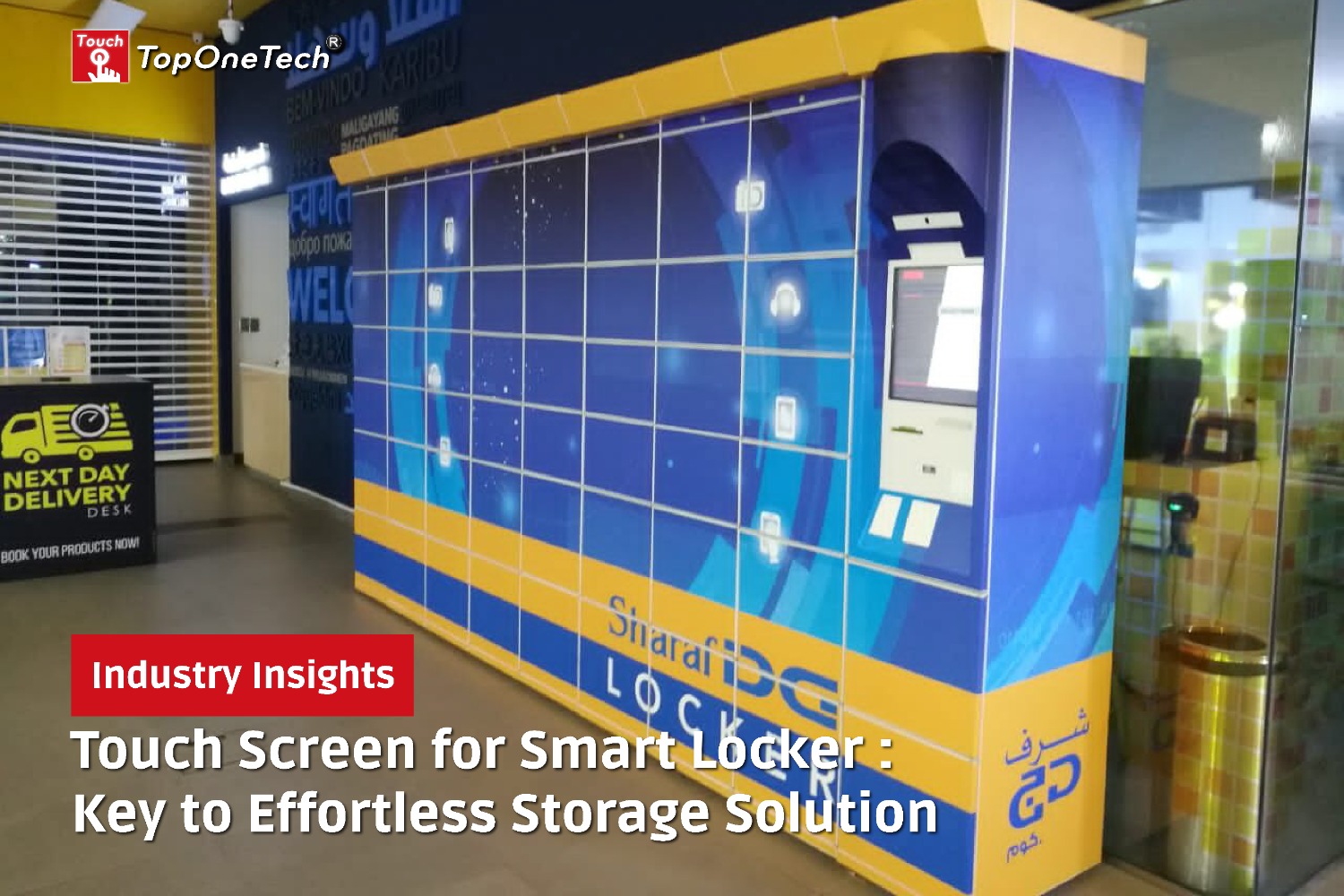
Touch Screen for ATM Machine : Banking Goes Digital – The transformation of the banking industry has been driven by advances in technology, particularly in how customers interact with banking services. One of the most revolutionary upgrades is the integration of touch screen technology in ATM machines. These modern ATMs now provide a level of interactivity that goes far beyond the capabilities of traditional push-button terminals. Customers today expect digital banking to be quick, intuitive, and user-friendly—just like the smartphones and tablets they use daily. By implementing touch screen interfaces, financial institutions are not just meeting expectations; they are redefining what convenient banking looks like. This article explores how touch screen ATM machines are streamlining operations, improving customer satisfaction, and opening new possibilities in banking.
The Rise of Touch Screen ATM Machines
Evolution of ATM Interfaces
ATMs have come a long way since their inception in the 1960s. Early models relied heavily on mechanical buttons, limited transaction options, and monochrome displays. These interfaces often created friction for users, especially those unfamiliar with banking technology or those requiring faster service. The transition to more modern displays began with the use of resistive touch screens, which allowed interaction by applying pressure. However, these had several limitations such as lack of durability and poor responsiveness.
Today, most ATMs feature capacitive touch screen displays, which offer smoother, faster, and more intuitive operation. These high-performance displays are similar to the screens used on smartphones, allowing users to swipe, scroll, and tap their way through banking transactions. This transition marks a major leap in customer engagement and service efficiency.
Global Shift to Touch-Enabled Banking
Across the globe, financial institutions are adopting touch screen technology in ATMs to support their digital transformation efforts. Whether in advanced economies or emerging markets, banks understand the importance of upgrading outdated machines to meet the growing demand for smart self-service banking. For instance, in countries like Singapore, Japan, and the United States, touch-enabled ATMs have become standard in both urban and suburban banking zones. Meanwhile, in developing nations, solar-powered and ruggedized touch screen ATMs are helping to extend financial services to rural and unbanked populations.
This global shift demonstrates not only a commitment to innovation but also an understanding of customer expectations. Consumers now associate touch interfaces with convenience and control—two vital aspects of modern banking experiences.
How Touch Screen for ATM Machine Improve ATM User Experience
Faster, Intuitive Navigation
One of the most significant benefits of ATM touch screens is the dramatic improvement in user interaction. Instead of navigating through layers of menus using arrow keys and physical buttons, users can directly select options on the screen. This reduces the time spent at the machine and makes the process far more intuitive, especially for customers who are already accustomed to smartphones and tablets.
Moreover, the flexibility of touch screen design allows for icons, colors, and visual cues to guide users seamlessly through transactions. Whether a customer is withdrawing cash, checking their balance, or transferring funds, the streamlined layout of touch interfaces makes banking more accessible and enjoyable.
Personalized Interaction
Touch screen interfaces are not just efficient—they are smart. Banks can program touch-enabled ATMs to recognize returning customers and display personalized greetings or frequently used services. For instance, a customer who typically performs mobile top-ups might see that option appear at the top of the menu, reducing the number of steps needed to complete the transaction.
Additionally, touch screens can be used to deliver personalized marketing messages or financial tips. They can highlight new services or notify users of account benefits, transforming the ATM from a mere transaction point into a personalized communication tool. This user-centric design approach improves satisfaction and deepens customer relationships.
Enhanced Accessibility
Accessibility is a key consideration in banking, and touch screen ATMs are a major improvement over traditional terminals. These interfaces can be customized to include larger fonts, high-contrast visuals, and voice-assisted navigation, making them ideal for users with vision impairments or limited literacy.
Furthermore, some touch screen ATMs are equipped with text-to-speech functionality, headphones jacks, and tactile guides, helping people with disabilities perform transactions independently and with dignity. These inclusive design features not only enhance the user experience but also help banks comply with regulations like the Americans with Disabilities Act (ADA) and other international accessibility standards.
Technology Behind Touch Screen for ATM Machine
Resistive vs. Capacitive Touch Screens
Understanding the underlying technology of ATM touch screens helps clarify why capacitive displays have become the preferred choice. Resistive touch screens work by detecting pressure applied to the surface, often using a stylus or fingertip. While they are less expensive and function well in harsh environments, they tend to wear out faster and offer lower sensitivity, making them less ideal for high-frequency use.
In contrast, capacitive touch screens detect the electrical properties of the human body, allowing for lighter touches, faster responses, and multi-touch functionality. These features are particularly beneficial in ATM environments, where speed, reliability, and accuracy are essential. Capacitive screens also tend to have better image clarity and are more resistant to wear and tear over time.
For these reasons, the majority of modern ATMs now use projected capacitive (PCAP) technology, which provides exceptional durability, supports gesture input, and allows for seamless integration with advanced user interface designs.
Display Durability and Security
ATM touch screens must operate reliably in public environments, which means durability is a top priority. These displays are built with reinforced glass panels, often made from tempered or chemically strengthened glass, which resists scratches, impacts, and tampering. The screens are also treated with anti-glare coatings, improving visibility even in direct sunlight—an essential feature for outdoor ATMs.
In terms of environmental resilience, many touch screens are sealed against dust, moisture, and extreme temperatures, ensuring stable performance in diverse locations. Advanced models even include vandal-proof casings to protect against physical damage and attempts at fraud.
On the security side, the move from physical keypads to on-screen virtual PIN pads adds another layer of protection. Banks can integrate features such as randomized number placement, screen shielding, and biometric authentication (e.g., fingerprint or facial recognition) to defend against common threats like shoulder surfing and skimming devices.
Benefits of Using Touch Screen for ATM Machine
Improved Operational Efficiency
Touch screen ATMs streamline operations for banks by reducing the number of moving parts and manual components that typically wear out or malfunction. With fewer mechanical buttons and keypads to maintain, these machines experience less downtime and require less frequent servicing. Software updates can be deployed remotely, allowing banks to introduce new services or interface enhancements without physically modifying the machine.
Additionally, the intuitive design of touch screen ATMs shortens transaction times, enabling more customers to be served per hour. This leads to better queue management and enhances overall branch efficiency. In busy locations such as malls, transport hubs, and bank lobbies, this increased throughput translates directly into higher customer satisfaction and lower operational costs.
Enhanced Security Features
Security is always a top priority in banking technology, and touch screen ATMs offer robust safeguards that go beyond traditional systems. On-screen PIN entry, for example, eliminates physical wear patterns that can give away user codes. Banks can also program touch interfaces to randomize number layouts or trigger alarms if suspicious activity is detected.
Touch screen ATMs can support two-factor authentication, such as combining card access with biometric verification or one-time passcodes sent to mobile devices. These additional layers reduce the risk of unauthorized access and build customer confidence.
Furthermore, software-based security solutions allow banks to monitor usage in real time, flag anomalies, and push updates instantly. As a result, touch screen ATMs are not only more secure but also more adaptable to evolving cybersecurity threats.
Versatile Functionality
Today’s touch screen ATMs are more than cash dispensers—they’re all-in-one financial service hubs. With multi-functional capabilities, these machines support a wide array of services, including:
-
Balance inquiries and mini-statements
-
Bill and loan payments
-
Funds transfers and mobile top-ups
-
Credit card payments and account updates
-
QR code scanning for digital wallet use
-
Document printing and e-KYC authentication
Touch interfaces make it easy to expand or customize service offerings. For example, a bank can introduce utility payment options or event ticket purchases without modifying the physical machine. This flexibility ensures that ATMs remain relevant, useful, and competitive in an age of ever-increasing digital demands.
Touch Screen for ATM Machine Applications in Banking Environments
Retail Banking
In retail banking branches, touch screen ATMs reduce the need for direct teller interaction. It is freeing up staff to handle complex queries and personalized customer service. These machines are ideal for high-traffic locations where quick, efficient self-service is a priority. Some banks use touch screen ATMs to facilitate appointment booking, account opening, and promotional campaigns. It is making the branch experience more interactive and productive.
Airport and Travel Banking
Airports and travel hubs present unique challenges for banking services due to language diversity, time constraints, and the need for foreign currency exchange. Touch screen ATMs in these environments are designed with multi-language support, dynamic currency conversion, and intuitive navigation that help travelers complete transactions quickly and independently. The sleek, space-efficient design of these machines also fits well into limited installation areas.
Microfinance and Rural Banking
In regions with limited traditional banking infrastructure, touch screen ATMs help financial institutions bridge the gap with underserved communities. With support for solar power, offline transactions, and biometric verification, these ruggedized ATM terminals enable secure and convenient access to financial services in remote locations. Governments and NGOs often collaborate with banks to deploy such solutions as part of financial inclusion initiatives. It is empowering users with savings, credit, and insurance services through a simple touch interface.
Choose the Right Touch Screen for ATM Machine Manufacturer
Selecting the right touch screen manufacturer is critical to ensuring long-term success in ATM deployments. Banks and kiosk integrators should look for manufacturers who offer:
-
Customization options, including screen size, brightness, and aspect ratio to suit different installation environments
-
Proven experience in supplying industrial-grade displays for banking and other high-security applications
-
Compliance with international standards such as CE, FCC, and ADA to ensure safety and accessibility
-
Durability features, including anti-vandal coatings, water resistance, and extreme temperature tolerance
-
Dedicated support for integration, testing, and long-term maintenance
One trusted name in this space is Top One Tech, a leading manufacturer of open-frame and embedded touch monitors specifically engineered for ATMs, kiosks, and self-service terminals. Our products combine advanced touch technology with rugged construction and customizable features. We are offering banks a reliable foundation for modernizing their ATM fleets.
Conclusion: A Smarter Way to Bank
The integration of touch screen technology into ATM machines is a powerful step toward more responsive, secure, and inclusive banking. From enhancing the user experience to increasing operational efficiency and expanding functionality, touch screen ATMs represent the future of financial self-service. Customers expect banking to match the speed and simplicity of digital devices. With the right technology in place, banks can deliver precisely that.
As financial institutions continue to modernize, investing in touch screen ATM solutions will be essential for staying competitive and building long-lasting relationships with customers in a digital-first world.
Top One Tech can manufacture Touch Screen for ATM Machines and we can also customize The ATM Machine Metal Cabinet, crafted by our subsidiary company, Top One Tech Metal, specially made for your application scenarios.
Don’t hesitate to contact us for further assistance :
Whatsapp/Call us at : +86 13631610695
Email : sales@toponetech.cn
See Also : Our Wide Range of Touch Screen Products




